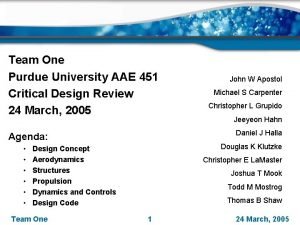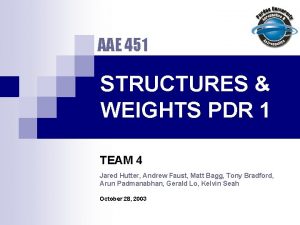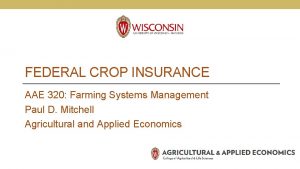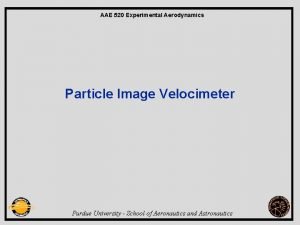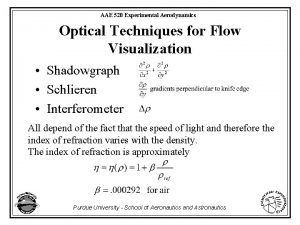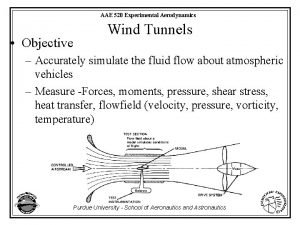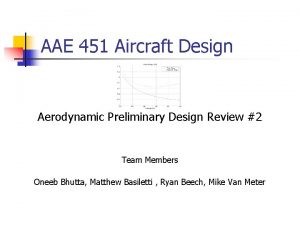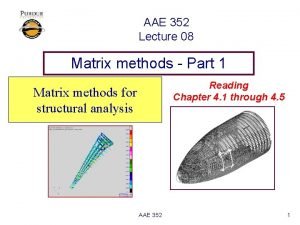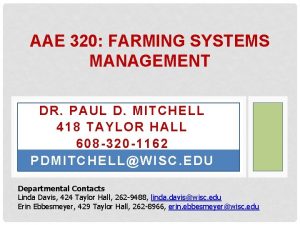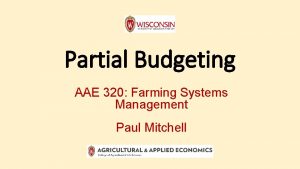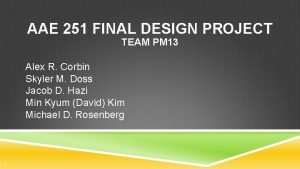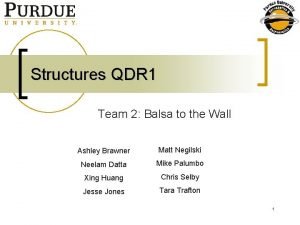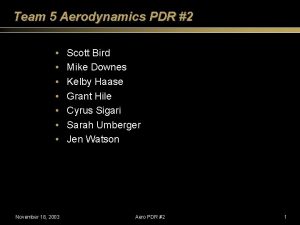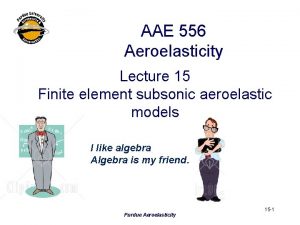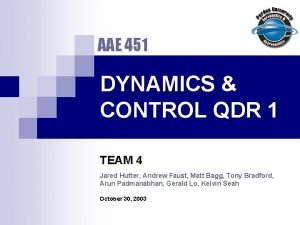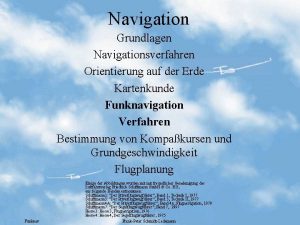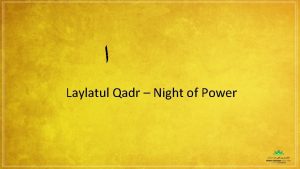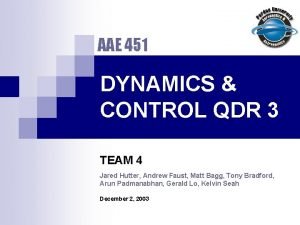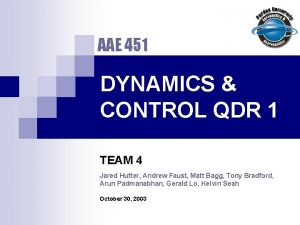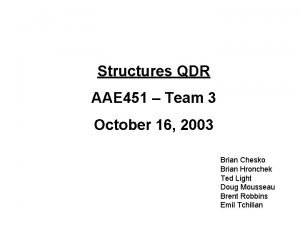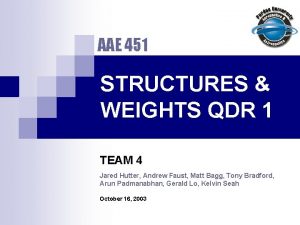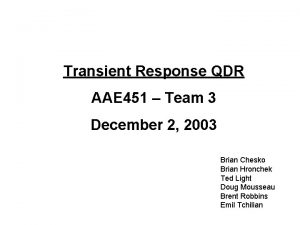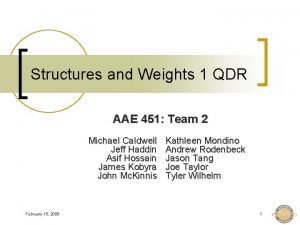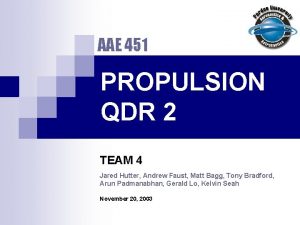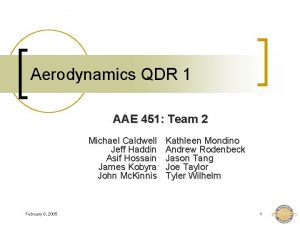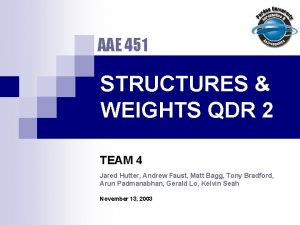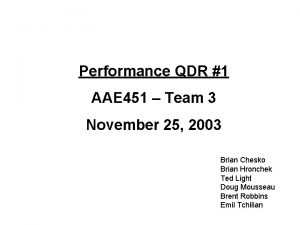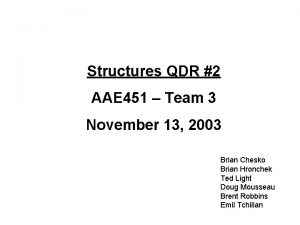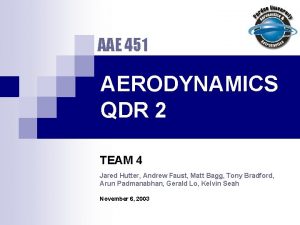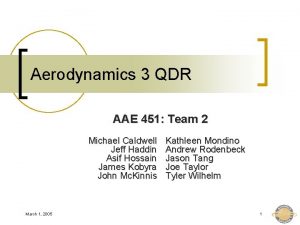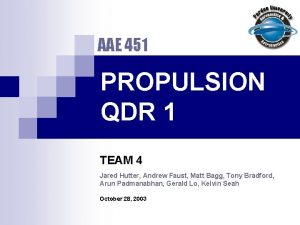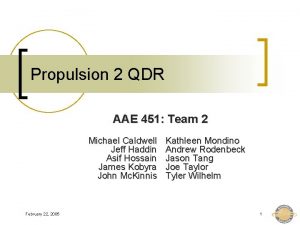AAE 451 DYNAMICS CONTROL QDR 1 TEAM 4

















- Slides: 17

AAE 451 DYNAMICS & CONTROL QDR 1 TEAM 4 Jared Hutter, Andrew Faust, Matt Bagg, Tony Bradford, Arun Padmanabhan, Gerald Lo, Kelvin Seah October 30, 2003

TEAM 4 n Concept Review n Class 1 Tail Sizing n Class 1 Control Surface Sizing n Believability Check n Verification of Sizing with Rudder Deflection in One-Engine Inoperative (OEI) Flight Conditions n Follow-Up Actions ITERATIONS OVERVIEW

TEAM 4 CONCEPT REVIEW Vertical Tails Horizontal Tail Main Wing Engine Avionics Pod Engine Landing Gear

TEAM 4 CLASS 1 HORIZONTAL TAIL SIZING n Tail Volume Coefficient Approach (Raymer, p. 124) n Equation used to find Horizontal Tail (HT) Area: where HT Volume Coefficient n n Tail Volume Coefficient Estimate ¨ Raymer, Homebuilt, ¨ AAE 451 Average, Selected larger = 0. 50 ≈ 0. 43 value because Table 6. 4 suggests that twin engines typically require larger tails. Wing Chord, 3. 1 ft Wing Area, 47. 8 ft 2 Moment Arm, 7. 3 ft

TEAM 4 CLASS 1 HORIZONTAL TAIL SIZING n Based on = 0. 50, the Horizontal 2 area was = 10. 10 ft. Tail calculated to be: n Aspect Ratio Selection ¨ We want where is now 5. 0. ¨ Selected ¨ Historically, many horizontal tails have = 3. 0 aspect ratios of ≈ 3. ¨ The tail protrudes ≈ 1¼ ft on each side; looks just about right.

TEAM 4 CLASS 1 VERTICAL TAIL SIZING n Same Tail Volume Coefficient Approach. n Equation used to find Vertical Tail (VT) Area: where VT Volume Coefficient Wing Span, 15. 5 ft Wing Area, 47. 8 ft 2 n n Tail Volume Coefficient Estimate ¨ Raymer, Homebuilt, ¨ AAE 451 Average, Selected = 0. 04 ≈ 0. 0388 Moment Arm, 7. 3 ft

TEAM 4 CLASS 1 VERTICAL TAIL SIZING n Based on = 0. 04, the Vertical Tail area was calculated to be 2 = 4. 04 ft Half Span n Aspect Ratio ¨ n Not important, because we want Taper Ratio ¨ Suggested Range: 0. 3 ¨ Prefer a high taper ratio for a small half-span. ¨ Selected = 0. 6

TEAM 4 CLASS 1 TAIL SIZING INITIAL RESULTS VERTICAL TAIL HORIZONTAL TAIL 1. 10 ft 1. 84 ft = 10. 10 ft 2 ½ = 2. 02 ft 2 1. 376 ft 1. 25 ft 3. 0 ft 1. 25 ft 5. 51 ft Recall: = 0. 50 = 0. 04 1. 84 ft

TEAM 4 CLASS 1 CONTROL SURFACE SIZING n n Raymer: Chord-wise Span-wise • Ailerons 0. 15 c. W ~ 0. 25 c. W 0. 5 b. W ~ 0. 9 b. W • Elevator 0. 25 c. HT ~ 0. 9 b. HT • Rudder 0. 25 c. VT ~ 0. 9 b. VT Initial Estimate: Chord-wise Span-wise • Ailerons 0. 2 c. W 12. 13 ft • Elevator 0. 5 c. HT 2. 67 ft • Rudder 0. 35 c. VT 0. 9 b. VT

TEAM 4 BELIEVABILITY CHECK Description of Symbols Used: Computed Typical 1. Variation of aircraft lift coefficient with elevator deflection angle. 1. 0. 195 0. 3 to 0. 9 2. Variation of aircraft pitching moment coefficient with elevator deflection angle. 2. -0. 476 -1 to -2 3. -0. 769 -3 to -15 Variation of aircraft pitching moment coefficient with dimensionless rate of change of angle of attack. (Important for Short Period damping. ) 4. Variation of aircraft pitching moment coefficient with pitch rate (damping in pitch). 5. Variation of aircraft yawing moment with sideslip (weathercock stability). Symbol 4. -4. 563 5. 0. 02 -11 to -30 0. 06 to 0. 20 All numbers are in units of rad-1. n n n Low elevator effectiveness? Low weathercock stability? Low damping in Short Period mode? We MAY need bigger tails!

TEAM 4 RUDDER DEFLECTION IN OEI CONDITIONS n Roskam (AAE 421 Textbook) n Required rudder deflection: n DRn. O: n Deflection Limit: n FAR 23, 25 requires that = 28 ft/s In this case, for = 0° = 37. 6 ft/s stall speed = 25° 1. 2 n deflection limit

TEAM 4 RUDDER DEFLECTION IN OEI CONDITIONS ref. “Airplane Flight Dynamics and Automatic Flight Controls” (Roskam) Section 4. 2. 6 [rad] where @ 2, 000 ft for fixed pitch [slug/ft 3] V [ft/sec] P [hp] y. T [ft]

TEAM 4 ITERATIONS n Varied Tail Volume Coefficients. n Performed Believability Check with Stability and Control Derivatives. n Analysis of OEI Rudder Deflection.

TEAM 4 CLASS 1 TAIL SIZING RESULTS VERTICAL TAIL HORIZONTAL TAIL = 14. 14 ft 2 1. 261 ft 2. 102 ft ½ = 3. 03 ft 2 1. 802 ft 1. 864 ft 3. 0 ft 1. 864 ft 6. 727 ft 2. 102 ft New Volume Coefficients: Chord-wise Span-wise = 0. 70 • Elevator 1. 05 ft 2. 67 ft = 0. 06 • Rudder 0. 35 c. VT 1. 62 ft

TEAM 4 RUDDER DEFLECTION IN OEI CONDITIONS n Roskam (AAE 421 Textbook) n Required rudder deflection: deflection limit n DRn. O: = 28 ft/s n Deflection Limit: n FAR 23, 25 requires that 1. 2 n In this case, for = 0° = 32. 86 ft/s stall speed = 25°

FOLLOW-UP ACTIONS n Class 2 Sizing for Tails and Control Surfaces n Further analysis on ¨ Desired static margin ¨ Aircraft performance parameters ¨ Other static stability issues TEAM 4

AAE 451 QUESTIONS?
